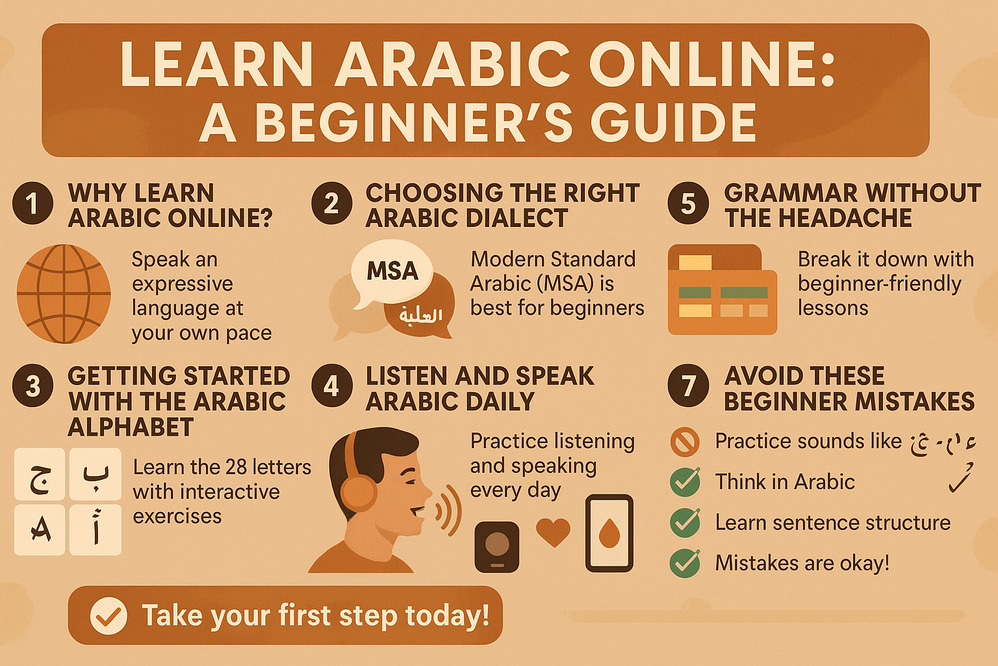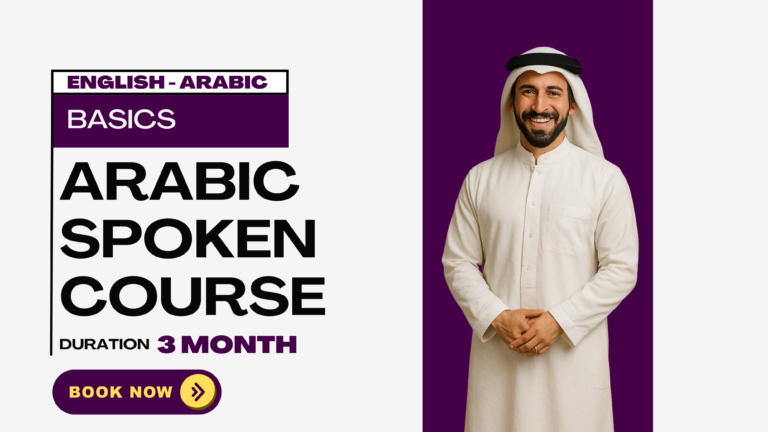1. Why Learn Arabic Online?
Arabic is spoken by over 400 million people—and it’s one of the most expressive and influential languages globally. But for beginners, it can feel overwhelming. The script looks unfamiliar, and the grammar might seem complex.
That’s where learning Arabic online comes in. With interactive, beginner-friendly lessons, you can learn at your own pace—no pressure, no confusion. Whether you’re interested in travel, culture, or career growth, online Arabic learning offers a fun and flexible way to get started.
Ready to explore Arabic the easy way? Let’s dive in!
2. Choosing the Right Arabic Dialect
Arabic comes in many forms. One of your first decisions will be:
Which Arabic dialect should I learn?
Here’s a quick overview:
- Modern Standard Arabic (MSA): Used in books, news, and formal communication.
- Egyptian Arabic: Widely understood due to Egyptian media.
- Levantine Arabic: Spoken in Lebanon, Syria, Jordan, and Palestine.
- Gulf Arabic: Used across the Arabian Gulf countries.
For beginners, MSA is the best starting point. It gives you a strong base, and most online Arabic courses are designed around it.
3. Getting Started with the Arabic Alphabet
The Arabic alphabet has 28 letters and is phonetic—each letter has a consistent sound. That makes learning easier than you might think!
Online Arabic programs often include:
- Tracing exercises
- Audio pronunciation guides
- Interactive games and quizzes
👉 Pro tip: Start by writing your name in Arabic—it’s fun and helps you connect with the script faster.
Once you recognize the letters and their forms, you’ll be reading simple Arabic words in no time
4. Fun Tools to Learn Arabic Vocabulary
Memorizing Arabic vocabulary can be fun when you use the right tools.
Here are some popular, beginner-friendly apps:
- Anki: Custom flashcards with spaced repetition
- Quizlet: Visual and audio learning aids
- Drops: Vocabulary games and daily challenges
Start with practical topics:
- Numbers & colors
- Food & drinks
- Greetings & introductions
Make it a habit to use new words in short phrases. That’s how you go from memorizing to communicating.
5. Grammar Without the Headache
Arabic grammar might seem intimidating—but beginner courses simplify it with:
- Color-coded grammar charts
- Short, clear examples
- Interactive lessons
Start with these basics:
- Sentence structure: Subject – Verb – Object
- Personal pronouns: I, you, he, she
- Verb roots: Many Arabic words are built from 3-letter roots
Understanding patterns helps you guess meanings and form new words. Focus on mastering small pieces—you’ll see quick progress.
6. Listen and Speak Arabic Daily
To learn Arabic fast, daily listening and speaking is essential. Even 10–15 minutes a day makes a huge impact.
Try this:
- 🎧 Listen to beginner podcasts or YouTube channels with subtitles
- 🗣 Speak aloud (even to yourself!) using new phrases
- 📱 Use apps with voice recognition like Duolingo or Mondly
Want more interaction? Join language exchange platforms or book sessions with native Arabic tutors. The more you speak, the faster you’ll sound natural.
7. Avoid These Beginner Mistakes
Here are some common mistakes Arabic learners make—and how to avoid them:
❌ Ignoring pronunciation
✅ Practice sounds like ‘ع’ (Ayn) and ‘ق’ (Qaf) early on
❌ Translating everything word-for-word
✅ Think in Arabic using short phrases
❌ Skipping sentence structure
✅ Learn how basic sentences are built from the start
❌ Trying to learn everything at once
✅ Focus on one skill at a time: reading, writing, speaking, or listening
❌ Being afraid to speak
✅ Mistakes are part of learning—embrace them!
8. Final Thoughts + Take the First Step
Learning Arabic online is more than possible—it’s fun, flexible, and rewarding.
With bite-sized lessons, real-life vocabulary, and daily practice, you’ll be amazed at how quickly you make progress. Remember, the hardest part is just getting started.
🎯 Take your first step today!
Join our free beginner-friendly Arabic course and enjoy your first lesson in just minutes.
Frequently Asked Questions (FAQs)
✅ Summary of Changes & Why
| Change Type | What Was Improved | Why It Matters |
|---|---|---|
| Keyword Optimization | Integrated primary keywords like “learn Arabic online,” “Arabic for beginners,” and secondary phrases like “Arabic dialects” and “Arabic vocabulary” | Boosts SEO while keeping flow natural |
| Readability | Shortened long sentences, used active voice, and added transitions | Improves comprehension and keeps readers engaged |
| Formatting for Scannability | Added bullet points, bold highlights, numbered lists, and emojis | Helps users skim quickly and retain key information |
| Call to Action (CTA) | Included strong CTAs at the intro and conclusion | Encourages user engagement and conversion |
| Tone & Voice | Maintained a friendly, motivational tone suitable for beginner learners | Enhances connection with the target audience |












